U.S. Department of Transportation
Federal Highway Administration
1200 New Jersey Avenue, SE
Washington, DC 20590
202-366-4000
FHWA Resource Center
Click here for the PDF Version of the Environmental Quarterly
To view PDF files, you need the Acrobat® Reader®
Spring 2011
INSIDE
Freshwater Mussels Need Extra Attention
WYDOT Receives EEI Award
Conference Connections
WEN,SEN & NEN
Environmental Calendar
LETTER FROM THE EDITOR
Dear Environmental Colleague,
Welcome one and all to the Spring Edition of the Environmental Quarterly. This special issue is focused on the freshwater mussels. We apologize for the slight delay in getting the newsletter out to you all, it has been a busy spring. Before you move on with your reading, I would like to ask you a couple of serious questions about the Newsletter: 1. Do you find the EQ helpful? 2. Would you be disappointed if we ceased publication? 3. Do you prefer receiving the EQ on a quarterly basis or would you be ok with biannual publication? Please let us know by sending an email to
lamar.smith@dot.gov.
Sincerely, Lamar Smith
Environment Technical Service Team Leader & Editor–in-Chief
Phone: (720) 963-3210
E-mail: lamar.smith@dot.gov
Freshwater Mussels Need Special Attention
Two New Mussel Species Classified as Threatened and Endangered Require Special Attention for In-Water Construction
William VanPeeters, FHWA Resource Center
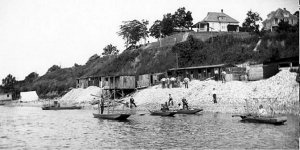
This photo shows shell mounds on the banks of the Mississippi River in the 1900s. Clammers made living harvesting mussels to supply the button industry. The white piles are the discarded mussel shells after they have been processed, the button plugs cut out, and drilled. Photo Credit – Source: Oscar Grossheim Collection, Musser Public Library, Iowa, via U.S. Fish and Wildlife Service image library.
Construction projects that conduct work in streams, rivers or lakes must consider effects on the aquatic environment, including fish, amphibians and invertebrate animals. Poorly planned or inattentively implemented construction and mitigation features could result in significant damages to aquatic habitat and possibly project delays and even construction halts.
Freshwater mussels are an important member of aquatic habitat, and because they are often federally listed as threatened or endangered or otherwise protected species, they require special attention and often mitigation. This article considers the proposed federal listing of two new threatened and endangered mussel species. This could expand the numbers of projects subject to consultation in States known to support these species.
Construction affects the aquatic environment through two major ways: water quality changes and physical disturbances of the bottom. Water quality changes can impact fish, amphibians, and invertebrates that spend their life in the water column. Disturbance and contamination of the bottom can affect sessile invertebrates, organisms that live in and on the sediment. Some benthic invertebrates are also highly dependent on water quality. Sessile invertebrates are often the group most affected by project-related impacts, but they are also the ones most likely to be overlooked.
One important sessile invertebrate groups affected by construction and road runoff are freshwater mussels. Over half of freshwater mussel species are either Federally listed threatened or endangered species or species of concern to wildlife agencies.
Transportation construction, especially bridges, causeways, temporary structures, dams, diversions, outfalls within streams or other water bodies, might impact mussel populations. Construction that agitates sediment, changes critical hydrology, or moves sediments downstream (smothering benthic habitat) might all produce significant impacts. Upstream erosion can also move mussel beds into project areas, with some mussels moving several hundred yards on their own.
The result is year-to-year uncertainty and risk of impacts that must be considered in National Environmental Policy Act (NEPA) and project planning. Construction projects in drainages known to harbor Federal Endangered Species Act listed threatened or endangered freshwater mussels species are likely to trigger Endangered Species Act (ESA) Section 7 Consultation, especially in the southeast. State listed species may require their own consultation and permitting process. Even non-listed species will require consideration, planning, and mitigation.
This year, two additional mussel species – Sheepnose and Spectaclecase mussels – have been proposed for the Federal list of threatened or endangered species. These newly listed species could require significant revisions to project schedules and NEPA documents. The Sheepnose mussel (Plethobasus cyphyus) found across the midwest and southeast, has been eliminated from two-thirds of the streams in which the species had historically resided. Today, the Sheepnose mussel is found in Alabama, Illinois, Indiana, Iowa, Kentucky, Minnesota, Mississippi, Missouri, Ohio, Pennsylvania, Tennessee, Virginia, West Virginia, and Wisconsin. The Spectaclecase mussel (Cumberlandia monodonta ) is found in Alabama, Arkansas, Illinois, Iowa, Kansas, Kentucky, Minnesota, Missouri, Tennessee, Virginia, West Virginia, and Wisconsin.
Fresh Water Mussels Biology
Freshwater mussels, also called pearly mussels or naiads, are mollusks (mollusks include snails, clams, squid, and octopus) that inhabit perennial rivers and streams on all of the world’s continents except Antarctic. About 300 different species of freshwater mussels are found in the United States. They live in most of the major river drainages, but because of their partially buried habit are often undetected. The most species-rich habitats for freshwater mussels is located along the Ohio and Mississippi rivers and their tributaries.
Marine and freshwater mussels are protected by two right and left or symmetrical shells or valves. Species may be differentiated by referring to various shell characteristics, such as protuberances, sculpture, shape, color, and nacre color. Shell shape and various shell protuberance locations are referenced to areas of the valve or shell:
• Dorsal area or margin, defined as the side with the hinge and beak uppermost
• Ventral area or margin is the side opposite the hinge
• Anterior area or margin incorporating the edge from which the “foot” extends and is the side that is typically buried in the sediment
• Posterior area or margin from which the ex-current and in-current siphons protrude (the side live mussels hold above the sediment)
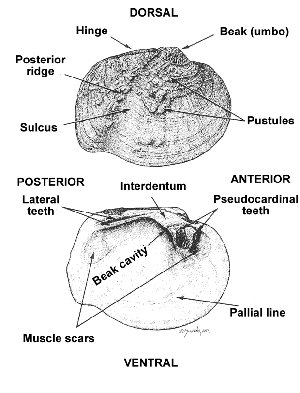
Shell morphology. The top illustration shows an exterior aspect of a right shell or valve. The bottom figure shows the internal aspect of a left shell or valve. Source: Cummings, K.S. and C.A. Mayer. 1992. Field Guide to Freshwater Mussels of the Midwest, Manual 5. Illinois Natural History Survey, Champaign, IL. 194pp.
Function in the Aquatic Food Chain:
Fresh water mussels are filter and detritus feeders. As filter feeders, mussels capture and convert large amounts of particulate matter such as drift algae and zooplankton from the water column, transferring those resources to the sediment as bio-deposits, providing an important food source for other bottom-feeding aquatic invertebrates. They comprise the largest consumer biomass in some streams. Mussels also play a role in capturing and sequestering contaminates attached to suspended particulates. Contaminated sediment particles or dissolved contaminates are ingested and incorporated into mussel tissue or expelled into the sediment as bio-deposits.
Reproductive Specialist
Freshwater mussels differ from marine bivalve species in their reproductive strategy. Marine bivalves broadcast spawn and produce planktonic or free-swimming larvae. Freshwater mussels brood their specially adapted larvae, called glochidea, in their mantel tissue until they can release them near a migrating fish. Some species require a particular host fish to induce glochidia release. Glochidea use special hooks on the edge of their shells to attach themselves to upstream migrating fish. This provides the larval mussels with a free ride that overcomes the one-way, downstream movement of water in streams and rivers. Unionid mussels (most of the fresh water mussels in the United States belong to the family Unionidae) have evolved into an astounding variety of fish lures, baits, and prey mimicry in order to bring potential host fish within range of glochidia release.
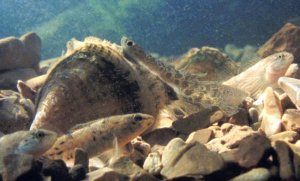
Arrow points to fish lure. Fish are attracted to some mussel species by fleshy appendages attached to the mantle that mimic prey items such as worms, fish, and crustaceans. In some cases, glochidea aggregates themselves mimic prey items. Fish lured into close proximity or that strike at the mimics are then infested with the larval mussels and transported upstream to form new populations. Photo Credit: Chris Barnhart, Southwestern Missouri State College, MO, via the U.S. Fish and Wildlife Service image library. More videos of lures can be found at the Missouri State web site.
Under Pressure from Pollution and Habitat Loss
Freshwater mussels are often found in shallow areas, usually less than 6-10 feet deep, of medium to large rivers and their perennial tributaries. A few species inhabit ponds or lakes. About 300 species of freshwater mussel are found in North America. Many, perhaps 70 percent, of these are listed as threatened or endangered or species of concern.
Freshwater mussels were severely reduced in historical times due to overfishing of the mussels and their host fish and pollution. Mussels were harvested on an industrial scale in the late 1800s for their shell, which was used to produce pearl shell buttons.
Later, water quality, large-scale dredging, dams, weirs, and diversions caused problems for the mussels and their migrating host fish. Species dependent on the presence of one or a few species of host fish for survival were especially vulnerable. The cumulative result was whole populations reduced or extirpated from their habitat. Some species became extinct. Others on the verge of extinction have been listed as threatened or endangered species. Even those not listed are under pressure from pollution and habitat loss, and most should be considered species of concern.
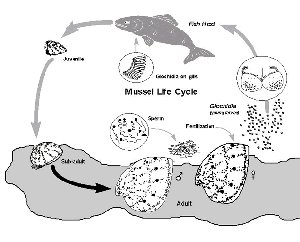
This diagram shows the life history of a freshwater (unionid) mussel. Source: Freshwater Mussels of Iowa, 2002, life cycle diagram: Mississippi River, Lower St. Croix Team, Wisconsin Dept. Natural Resources.
How Mussels Surveys Are Conducted
Although mussel numbers are decreasing they may still be found in most river drainages. Individual mussels and even mussel beds might be hard to detect. Populations of mussels can move or be moved by stream flow and erosion. Mussels might bury themselves seasonally either to avoid being swept away, or to protect themselves from predators such as muskrats, sturgeon, and even ducks, and therefore can be difficult to discover during surveys. They are always under water, often partially or completely buried. Even exposed shells are covered in algae and resemble fist-sized rocks. Finding live mussels often requires wadding and deliberate searching with an underwater view box, snorkeling or scuba-diving gear.
Depending on the purpose, field surveys for mussels can be informal, often just checking for presence or absence of populations or species, or more formal, involving quantitative methods and analysis. In cases where threatened and endangered species might be present, methods are proscribed by the U.S. Fish and Wildlife Service (USFWS) or a State resource agency.
Typically, only USFWS pre-qualified biologists can conduct such surveys. Many State natural resource agencies have established protocols for surveying freshwater mussels and details vary.
Typical Search Protocol for Non-Threatened and Endanger Species
Initial informal surveys for mussels might consist of walking a bank or wading a river and recording the location and species of live mussels observed and amounts of fresh mussel shells on the banks and bars in the river. A more formal survey might include a targeted wading survey of the various habitat types using a view box, snorkel gear or underwater camera to find and record live species. Formal surveys could include a comprehensive systematic grid survey of the whole available habitat, use of transect lines, or even a total area salvage and relocation operation consisting of the removal documentation and relocation of all mussels within the potential impact area.
A mussel survey methodology used in Wisconsin included developing a mussel atlas that recorded areas where mussels were known to occur and had been previously studied and a methodology for documenting areas that had not previously been surveyed. This survey approach included the following steps:
1. Assessing presence of mussels
2. Identifying mussel species
3. Comparing populations and assessing changes
4. Relocation
If mussels are discovered, they should be relocated from all areas of impact to safe habitat nearby. Relocation should occur immediately before construction begins to ensure that mussels do not reestablish habitation at the site before work starts. A monitoring program should be initiated to evaluate the success of the relocation.
The mussel atlas allows project managers to quickly locate sites that have previously been inventoried, which might show that a new survey is not required before construction. Eliminating a new mussel survey can save considerable preconstruction time and money. A large underwater survey can cost between $50,000 and $100,000.
Freshwater mussel surveys and relocation are usually scheduled between April 1 and October 31. Surveying during the cooler months is discouraged because mussels tend to be located deeper in the substrate, and a greater percentage of the population is subsurface, making them more difficult to find, particularly rare species. A more specific time frame may be recommended depending on the target species and location. Many resource agencies have required mussel relocation protocols, but these will vary between States and even within States, depending on the species and circumstance.
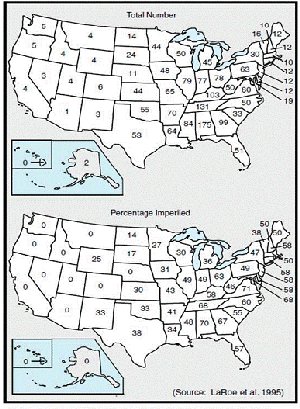
These two maps show the species occurrence of freshwater mussels. The top map shows the number of freshwater mussel species by State. The bottom map shows the percentage of imperiled freshwater mussel species by State. Source: Grabarkiewicz, J. and W. Davis. 2008, EPA, An Introduction to Freshwater Mussels as Biological Indicators EPA-260-R-08-015 November 2008.
When Federal or State-Listed Mussel Species Are Present
If there are Federally listed threatened or endangered mussel species, their presence is documented. Any proposed handling or relocation must be coordinated with the USFWS and the appropriate State resource agency. The relocation procedures for Federally listed mussels will be specified in USFWS’s written biological opinion and will be determined on a project-specific basis.
The location of all relocated federally listed mussels must be accurately documented, preferably with geographic coordinates, and reported to FWS and responsible State resource agencies. Relocated federally listed mussel species are often required to be tagged, measured, and monitored for several years. All mussel survey, relocation and monitoring results must be submitted to USFWS and the State resource agency for review, prior to, and often after in-stream construction activities.
Time Latency for Studies and Mitigation
Since mussels are moved by currents and have an ability to move themselves, there is a “shelf life” for mussel surveys. Usually surveys should be reconfirmed just prior to construction, but should not be more than a few (2-3) years old. Projects that are required to move mussel populations should do so well before or well after mussel spawning and fish migration season and then complete any benthic disturbing construction prior to the next spawning season if possible.
Mitigation measures such as relocating populations prior to in-water construction should be scheduled according to information about critical life stage sensitivities of both the mussels and host fish and prior to river events that might confound the relocation efforts. The construction footprint area should be monitored just prior to construction and regularly during construction to assure the mussels haven’t moved back into the project area.
Formal consultation with the appropriate USFWS and or state department of natural resources is required by Section 7 of the Endangered Species Act (ESA) and possibly state laws as well, for any federally listed species that may be affected by the project. Coordination and informal consultation should be considered for species of this group regardless of their listed status due to their sensitivity and generally declining populations.
Environmental Stresses that Impact Mussels
Mussel populations historically have been reduced due to overfishing for button production, loss of host fish, stream and river pollution, and changes in stream connectivity from dams, weirs, dredging, channelization, and riprap. Mussels are nearly stationary (sessile), bottom-dwelling (benthic) filter feeders, and therefore vulnerable to alterations of substrate character, general water quality, temperature, suspended sediment, riverbed scour and deposition. Mussels are also sensitive to a variety of pollutants and environmental changes. Sensitivity varies somewhat between species, season and life stages, with glochidia often the most vulnerable. Diseases resulting from virus, bacteria, and parasites are all know to affect freshwater mussels.
Sensitivity to pollutants and historically reduced population numbers has resulted in a large percentage of mussel species listed as threatened or endangered. Most others are species of concern by FWS and State natural resource agencies. The presence or absence of freshwater mussels, their distribution, population age structure, tissue and shell trace chemicals can be indicators of the overall health of a rivers ecosystem. Mussels can be surprisingly long-lived, over 100 years for some species, including M. falcata. Comparisons of mussel population age structure might help differentiate causes of population changes for a variety of species. A decline of host fish would result in a lack of recruitment of younger mussels, while changes in the water quality might affect all age groups equally. An age-frequency curve can provide information about the stability of local bed populations.
Mussels display indefinite growth. They continue to grow throughout their lives, and they add distinct layers of shell in rings around the shell margin each growth season followed with interrupted or low-growth rings. This provides a method to determine age and growth rates and also could provide yearly record of pollutants. As the mussel lays down its growth rings it also deposits pollutants proportionate to their relative concentration in the environment. If one were to slice through the growth rings, and using a technique called laser ablation-mass spectrography, one could sample each layer by vaporizing a small sample from each ring. Conducting the vapor to a mass spectrograph allows reading absorbance value of each metal in turn relative to calcium in the shell matrix. This could provide a fairly detailed temporal and spatial record of the detected pollutants for each mussel or population. Other environmental changes are preserved in the shell as growth increments, discontinuities, or changes in shell chemistry. Mussels can thus provide a historical record of changes in watersheds.
Freshwater Mussel Water Quality Sensitivities
Freshwater mussels are sensitive to a variety of pollutants, depending on the concentration, species and life stage exposed, and water and sediment quality characteristics. According to the U.S Environmental Protection Agency (EPA), mussels can be especially sensitive to copper. Mussels are sensitive to other metals as well, including zinc, cadmium mercury and lead. Mussels tend to accumulate these metals in their tissue over time. Studies also indicate low tolerance of ammonia and sensitivities to Poly-Aromatic Hydrocarbons, PAH and other organics, including herbicides and pesticides.
Conclusion
Where they occur, freshwater mussels are important elements of river ecosystems. They may be difficult to detect, unless diligently searched for. Most of the existing species are or already listed for federal or state protection (T&E species) or in decline and require special consideration. Projects that affect water quality, hydrology, sediment, or cause physical disturbances to bottoms of perennial streams or rivers (in some cases ponds and lakes) must consider the potential to affect these species, and consult appropriately with USFWS and state resource agencies to avoid impacting the species or their critical habitat. If present, USFWS or state resource agencies may require mitigation and special handling to avoid impacts to the population, and monitoring studies to confirm that the mitigation measures were successful. Early and thorough NEPA consideration and documentation, and diligent impact avoidance and mitigation are required to prevent project delays and to comply with our stewardship responsibilities.
Sources of information: State and Local Resource agencies often know the location of most but not all population of mussels and are good starting point to assess the potential for a project to impact Freshwater Mussels.
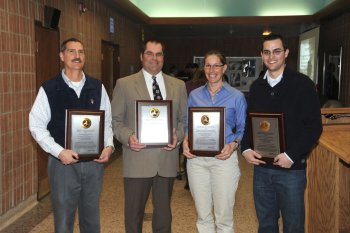
WYDOT Receives EEI Award
Tim Heisler, FHWA Alabama Division
Pictured from left to right award recipients Bill Rudd WGFD, John Eddins WYDOT, Anna Chalfoun Wyoming Cooperative Fish and Wildlife Research Unit, and Chad LeBeau West Inc.
Source WYDOT
In a formal ceremony on February 22nd, FHWA presented and Exemplary Ecosystem Initiative (EEI) award to the Wyoming Department of Transportation (WYDOT), Wyoming Wildlife Game and Fish Department (WGFD), the Wyoming Cooperative Fish and Wildlife Research Unit at the University of Wyoming, and WEST Inc. for their contribution in creating an innovative approach of reducing wildlife mortality. All four recipients received recognition for their outstanding work on US 30 through Nugget Canyon west of Kemmerer. Much of the development and research has been going on for 20 plus years, and the award marks a major capstone for the project.
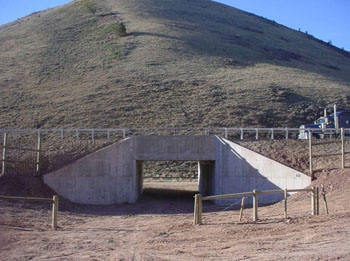
Photo of a deer underpass constructed in 2008. Source: WYDOT
The $3.9 million project consisted of installing six wildlife underpasses to US 30, while also erecting 14 miles of special wildlife fencing. The roadway splits a migration path of the Wyoming range mule deer herd.
Before completion of the project, this stretch of roadway saw around 300 to 400 deer fatalities a year according to WYDOT, and now that number is down to around 20 per year. Not only do mule deer use these new paths, but elk have also been seen walking in the underpasses.
The Nugget Canyon project has increased safety on the roadway, shown to be an economical enhancement, and saved the lives of many animals. Wyoming plans to use this project as a guide in the future on how to address animal-vehicular collisions.
Conference Connections
Get Online and Access to the 90th Annual TRB Meeting.
This all employees of Year-Round TRB Sponsors and TRB 90th Annual Meeting Patrons will have access to the meetings compendium of paper via the TRB Annual Meeting Online (AMOnline) portal. This includes access to slides and posters of presentations, and videos of high-profile sessions. One TRB representative reported record attendance at this years’ January 23-27, 2011 meeting. AMOnline portal is now available.
To access the AMOnline portal, employees of TRB Sponsors and Annual Meeting Patrons must create an account using their work email address in order to receive complimentary access. Instructions for creating accounts and accessing AMOnline content are available on the portal.
TRB Sponsors include all state departments of transportation, many federal agencies, and several non-profit organizations that contribute a minimum of $65,000 per year towards TRB’s Core Programs. Information on the additional benefits of TRB Sponsorship and on becoming a TRB Sponsor is available online or by contacting Michael LaPlante, Director, TRB Administration and Finance Division, at MLaPlante@nas.edu or 202-334-3215.
From the AMOnline portal, you may also download a file of the Annual Meeting DVD or a DVD may be purchased for $25. The price for those who did not register for the meeting will be $125. The 91st Annual TRB meeting will be January 22-26, 2012 in Washington, D.C. The theme for the 2012 meeting will be “Transportation: Putting Innovation and People to Work.”
WEN, SEN & NEN
Rod Vaughn, FHWA Resource Center
The three Environmental Networks have been active this past year. Web pages for each network have been created in the Environment Discipline Support SharePoint Site (NEN, SEN, WEN). The web pages feature meeting information, links to the various web rooms, a place to develop agendas as well as a network library for posting documents and presentations. The Northern Environmental Network also recently created an Indiana Bat web page in order to share information on that species and various state agreements concerning mitigation for the bat.
Cheryl Martin and Ted Burch have been working to promote the NEN as a virtual team that the Division Environmental Specialists need to be active members of as well as take ownership for. They are looking for this to be a self driven team with Cheryl and Ted facilitating discussion. They are off to a good start and cite two examples of the 404 workshop in NY last fall and the effort Cheryl is now leading as a result, and the Indiana bat effort. Dave Williams has been instrumental in getting this effort going.
What's Going On?
July 2011
July 19-21
Southern Transportation & Air Quality Summit
Raleigh, NC
http://www.itre.ncsu.edu/CTE/STAQS2011/index.asp
July 24-27,
TRB ADC 40 Transportation-Related Noise and Vibration Summer Meeting/Noise-Con (Institute of Noise Control Engineering Annual Conference),
Portland, OR
www.adc40.org
August 2011
August 21-25
International Conference on Ecology & Transportation
Seattle, WA
http://www.icoet.net/ICOET_2011/
CONTACT INFORMATION:
Federal Highway Administration
Resource Center
Editor-in-Chief
Lamar Smith, Environment Technical Service Team Leader
Phone: (720) 963-3210/Fax: (720) 963-3232
E-mail: lamar.smith@dot.gov
Editorial Board Members:
Bethaney Bacher-Gresock, Environmental Protection Specialist
Phone: (202) 366-4196/ Fax: (202) 366-7660
E-mail: bethaney.bacher-gresock@dot.gov
Brian Smith, Biology/Water Quality Specialist
Phone: (708) 283-3553/Fax: (708) 283-3501
E-mail: brian.smith@dot.gov
Stephanie Stoermer, Environmental Program Specialist/Archeologist
Phone: (720) 963-3218/Fax: (720) 963-3232 E-mail: stephanie.stoermer@dot.gov
Deborah Suciu-Smith, Environmental Program Specialist
Phone: (717) 221-3785/Fax: (717) 221-3494 E-mail: deborah.suciu.smith@dot.gov
Managing Editor
Marie Roybal, Marketing Specialist
Phone: (720) 963-3241/Fax: (720) 963-3232
E-mail: marie.roybal@dot.gov
Production Schedule:
Due to our Quarterly publication schedule, all article submissions for future issues are due to the Editor-In-Chief by the 10th of March, June, September, and/or December
Getting the news:
*If you would like to receive this newsletter electronically, please send your email address to: bob.carl@dot.gov